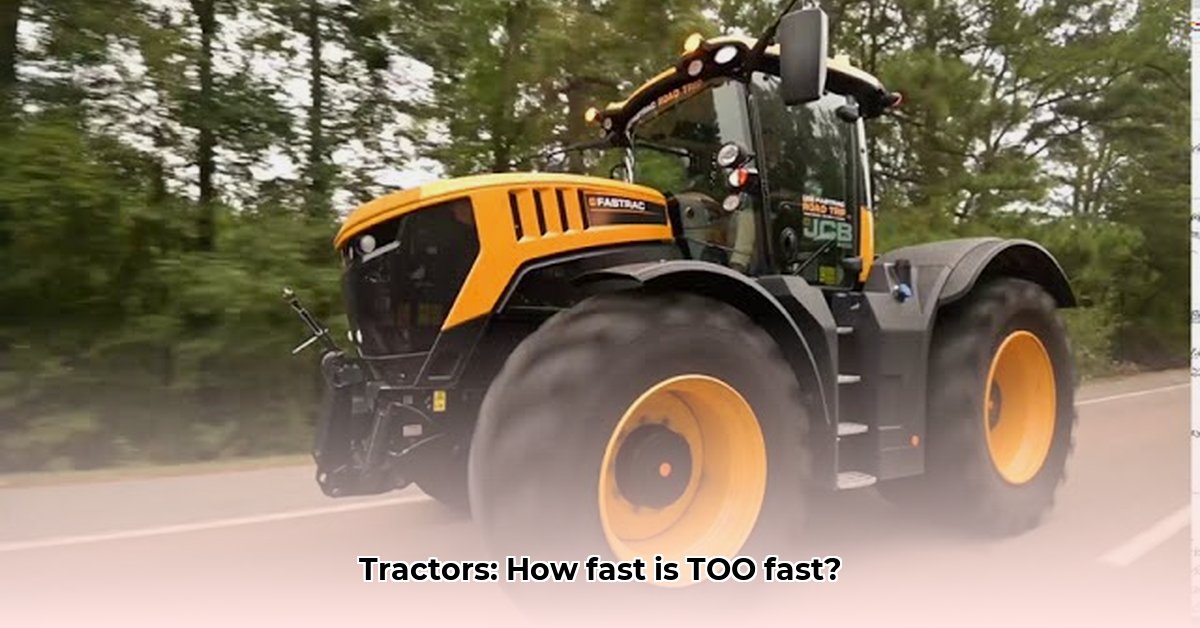
Ever wondered about the top speed of a tractor? It's more nuanced than a simple number. This article explores the factors influencing tractor speed, from engine power to terrain, and how speed impacts sustainable farming practices. We'll examine the trade-offs between speed and efficiency, offering actionable advice for farmers, manufacturers, and policymakers. For more information on used tractor values, check out this helpful resource: Used Tractor Values.
Tractor Speed: A Multifaceted Equation
A tractor's speed isn't solely determined by horsepower. Think of cars – a sports car is faster than a minivan, despite potential engine power similarities. Similarly, tractor speed depends on a complex interplay of factors. A small garden tractor might reach only 10 mph, while a large agricultural tractor can easily exceed 20 mph. Specialized racing tractors, designed purely for speed, have even topped 100 mph! But our focus remains on everyday farming operations.
Maximum Speed vs. Practical Application
While some tractors can attain high speeds, their practical speed during typical farming tasks is crucial. Maximum speed isn't always synonymous with efficient farming. Excessive speed increases fuel consumption and can damage the soil.
Factors Affecting Tractor Speed
Several factors influence a tractor's operating speed:
- Engine Power: More powerful engines generally equate to higher top speeds (similar to larger car engines).
- Transmission: Manual transmissions offer more control but might be slower than automatic or continuously variable transmissions (CVTs), which provide smoother speed changes and potentially higher speeds.
- Tire Size: Larger tires usually translate to higher speeds, but also impact traction. Larger tires navigate rough terrain better but may reduce efficiency in certain conditions.
- Terrain: Uneven or challenging terrain (hills, rocks) significantly reduces safe operational speeds.
- Load: Heavier loads (e.g., a full trailer) decrease a tractor's speed.
- Weather Conditions: Adverse weather (mud, ice, heavy rain) drastically reduces safe operating speeds.
Key Takeaway: Understanding these factors allows farmers to optimize their tractor usage for both productivity and safety.
Sustainable Farming and Tractor Speed: Striking a Balance
High-speed tractors offer increased productivity, potentially lowering labor costs. However, increased fuel consumption and soil compaction present significant drawbacks. Soil compaction reduces water absorption, hinders crop growth, and contributes to erosion. Sustainable farming necessitates a balanced approach.
The Pros and Cons of High-Speed Tractors
| Factor | Advantages | Disadvantages |
|---|---|---|
| Higher Speed | Increased productivity, potentially lower labor costs | Increased fuel consumption, soil compaction, safety risks |
| Fuel Efficiency | Reduced operating expenses | Requires investment in advanced, more expensive models |
| Soil Compaction | None | Reduced water absorption, poorer crop yields, soil erosion |
Key Takeaway: High speed offers efficiency benefits, but only when coupled with soil-conservation measures.
Actionable Steps for Sustainable High-Speed Farming
How can we optimize tractor speed for sustainability?
For Farmers: Assess your needs. A high-speed tractor might not offer optimal efficiency for all farms or terrains. Consider using precision farming techniques (GPS guidance) to maximize efficiency without damaging the soil.
For Manufacturers: Develop tractors that are both powerful and fuel-efficient, while minimizing soil compaction. Innovations in tire technology, weight distribution, and transmission systems are crucial.
For Policy Makers: Implement policies and financial incentives promoting sustainable agricultural technologies. This could include subsidies for fuel-efficient tractors or tax breaks for farmers using sustainable farming practices.
Key Takeaway: Collaboration across stakeholders is key to creating agricultural systems that balance productivity and environmental sustainability.
Minimizing Soil Compaction with High-Speed Tractors
High-speed operation increases the risk of soil compaction, reducing water infiltration and hindering root growth. However, several strategies can mitigate this issue:
Techniques to Minimize Compaction
Controlled Traffic Farming (CTF): Designate permanent traffic lanes to concentrate compaction in smaller areas, protecting the majority of the field. This approach improves soil aeration and water penetration between lanes.
Tire Technology: Wide, low-pressure tires distribute weight more evenly, reducing ground pressure and minimizing compaction. Advanced tire-pressure management systems allow for adjustments based on soil conditions.
Precision Agriculture: GPS-guided systems maintain consistent tractor operation, reducing overlaps and slippage, which contribute to compaction.
Cover Cropping: Planting cover crops enhances soil structure, leading to increased resistance to compaction.
Optimal Speed Management: Adjust speeds based on soil moisture and conditions; avoiding excessively high speeds, particularly in wet conditions.
Key Takeaway: Implementing a combination of these strategies offers the most effective means of mitigating soil compaction even at higher speeds.
The Importance of Ongoing Monitoring
Soil conditions are constantly changing. Regular monitoring and adjustments are crucial for optimal compaction management. Soil density gauges allow real-time assessments and informed decision-making. A sustainable future requires a dynamic and well-informed approach.